Search the Special Collections and Archives Portal
Search Results
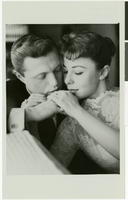
Photograph of Steve Lawrence and Eydie Gorme at their wedding, Las Vegas (Nev.), December 29, 1957
Date
Archival Collection
Description
An up close view of Steve Laurence and Eydie Gorme holding hands at their wedding in Las Vegas, Nevada.
Image
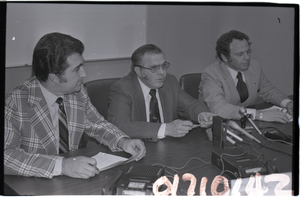
Film negative of the Police Commission, February 1980
Date
Archival Collection
Description
Members of the Police Commission, from left to right: Ron Lurie, Paul Christensen, and Al Levy, most likely in Las Vegas, Nevada.
Image
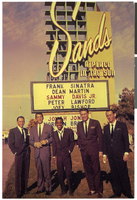
Postcard of of the Rat Pack in front of the Sands Hotel, Las Vegas (Nev.), 1950s
Date
Archival Collection
Description
The "Rat Pack" posed in front of the Sands marquee in Las Vegas, Nevada. From left to right: Frank Sinatra, Dean Martin, Sammy Davis Jr., Peter Lawford, and Joey Bishop. Postcard is from Quantity Postcards (1987).
Image
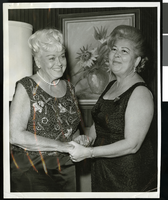
Photograph of Grace Hayes and Bess Rosenberg, Las Vegas (Nev.), December 1965
Date
Archival Collection
Description
Grace Hayes, left, and Bess Rosenberg, right, at a Christmas event in Las Vegas, Nevada. Handwritten description provided on back of image: "1965 Bess Rosenberg; Grace Hayes; Xmas - Las Vegas Nevada; For - crippled children - I came back to the stage - scared to-death. They gave me a standing ovation what a joy/what a ham - but it was a good feeling after being in wheel chair almost nine years - So grateful to God almighty I am walking and I have you "all" my blessed children how lucky can one person be? God bless you this Holy Christmas. Bring you peace - "Kay" "Bop" (sp?)."
Image
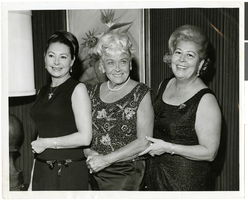
Photograph of Grace Hayes and Bess Rosenberg, Las Vegas (Nev.), December 1965
Date
Archival Collection
Description
From left to right: an unidentified woman, Grace Hayes, and Bess Rosenberg at a Christmas event in Las Vegas, Nevada. Handwritten description provided on back of image: "Xmas at Las Vegas 1965. Big Bess - Grace Hayes - do not know name of other lady but connected with Variety Club. They "all" work like beavers for handicapped children. Wonderful organization Variety Club. I never saw women work this hard - big job too much book keeping and begging for help, at times demanding more or less - they have no fear, for its all for the love of God, charity - Kay "Pop" (sp?) Keep these pictures please."
Image
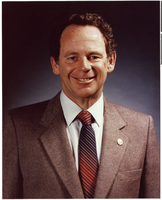
Photograph of City Councilman Alvin "Al" Merrill Levy, 1979-1987
Date
Archival Collection
Description
A portrait of Alvin "Al" Merrill Levy, who was a Las Vegas City Councilman from 1979 - 1987.
Image
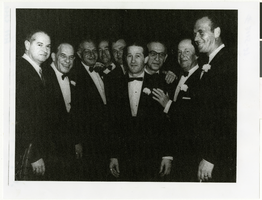
Photograph of "The Gang" at Ronzone's Department Store, Las Vegas (Nev.), 1940s -1950s
Date
Archival Collection
Description
A group photograph of "The Gang" or "Mob" at Ronzone's Department Store in Las Vegas, Nevada. Handwritten description provided on back of image: "L - R: 1) Sam Diamond 2) Gus Greenbaum 3) Willy Alderman 4) Davie Berman 5) Jack Prcras (sp?) 6) "Bowser" Joe Rosenberg 7) Sam Belkin 8) Ed Barrick 9) Sam Prcras (sp?)."
Image
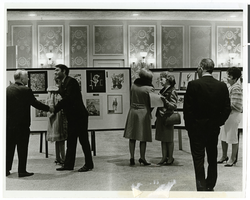
Photograph of Vassili Sulich at his art exhibit in the Tropicana Hotel, Las Vegas (Nev.), 1960s
Date
Archival Collection
Description
Vassili greeting Mr. and Mrs. William Shapiro at his art exhibit in the Gold Room at the Tropicana Hotel in Las Vegas, Nevada. Handwritten description provided on back of image: "Vassili Sulich greeting Mr. & Mrs. William Shapiro at his art exhibit - Gold Room, Tropicana Hotel, Las Vegas, Jan 27. (Mrs. Shapiro behind Vassili). Others l. to. r. : Mrs. Maury Stevens, Mrs. Preston Feinberg, Maury Stevens, Mrs. Q. E. Fortier. (Maury Stevens is editor and publisher of Las Vegas Life Magazine). Preston Fienberg is exec. V. P. of Tropicana. Mrs. Fortier is wife of Dr. Q. E. Fortier, owner of Women's Hospital (L.V.) and one of the nations leading gynecologists, former prof. of anatomy at Univ. of Minn. and Colonel in Air Force attached to Nellis Air Force (L.V.). He also was called in on the recent tragedy of the Apollo at Cape Kennedy; he flew out the same day, Jan 27th."
Image
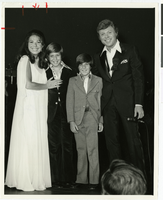
Photograph of Eydie Gorme, Steve Lawrence, and their sons, Las Vegas (Nev.), November 18, 1977
Date
Archival Collection
Description
Eydie Gorme, far left, Steve Lawrence, far right, and their two sons, David (center left) and Michael (center right), onstage in Las Vegas, Nevada.
Image
Audio clip of interview with Sharon Walker by Barbara Tabach, October 8, 2014
Date
Archival Collection
Description
Part of an interview with Sharon Walker on October 8, 2014. In this clip, Sharon Walker is talks about family and life in Las Vegas.
Sound
